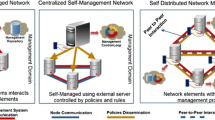Abstract
The recent advances in network management systems suggest the adoption of autonomic mechanisms in order to minimize the need for human intervention while handling complex heterogeneous networks. Data acquisition performed by monitoring processes is an essential part of autonomic mechanisms. The rate of sampling is a crucial factor since it is related to (1) the successful/unsuccessful detection of events, (2) the processing power needed to perform the sampling and (3) the energy that a node consumes during such actions. In order to address these issues we designed a simple and efficient mechanism that dynamically adapts the sampling rate of the context monitoring procedure. The merits of the mechanism are quantified by means of an analytical model as well as through extensive simulations that validated the theoretic outcomes. Finally, we experimentally assessed the effectiveness and efficiency of our approach through two real-world experiments. Overall results showcase that our mechanism achieves high detection rates while in parallel minimizes significantly the number of monitoring loops thus, emerges as a viable approach for context monitoring optimization in autonomic networks.











Similar content being viewed by others
Notes
The algorithm is generic in nature, thus the same procedure can be used for monitoring events which require minimum processing time (e.g. movement) or a significant amount (interference identification in IEEE 802.11 networks).
A slot can have a duration of x milliseconds depending on the context of implementation. In order to simplify the presentation, we purposely omit time duration, however the concept of the time-slotted model inherently incorporates it.
Self-evolving cognitive and autonomic networking Laboratory: http://scan.di.uoa.gr.
References
Stefania, S., Issam, T., & Matthew, B. (2009). LTE The UMTS long term evolution. From theory to practice. Wiley, ISBN: 978-0-470-69716-0.
Dobson, S., Denazis, S., Fernández, A., et al. (2006). A survey of autonomic communications. ACM Transactions on Autonomous and Adaptive Systems, 1(2), 223–259.
Agoulmine, N. (Ed.). (2011). Autonomic network management principles: From concepts to applications. New York: Elsevier/Academic Press.
Fortuna, C., & Mohorcic, M. (2009). Trends in the development of communication networks: Cognitive networks. Computer Networks, 53(9), 1354–1376.
Samaan, N., & Karmouch, A. (2009). Towards autonomic network management: An analysis of current and future research directions. IEEE Communications Surveys and Tutorials, 11(3), 22–36.
Tsagkaris, K., et al. (2013). A survey of autonomic networking architectures: Towards a Unified Management Framework. International Journal of Network Management, 23(6), 402–423.
3GPP. Telecommunication management; Self-Organizing Networks (SON); Concepts and requirements. 3rd Generation Partnership Project (3GPP), TS 32.500, Dec. (2011).
4G Americas. Self-Optimizing Networks in 3GPP release 11: The benefits of SON in LTE, October 2013. http://www.4gamericas.org/documents/Self-Optimizing%20Networks-Benefits%20of%20SON%20in%20LTE_10.7.13.pdf.
Bochow, B., Emmelmann, M., Makris, A., Kaloxylos, A., & Koudouridis, G. (2012). The self-growing concept as a design principle of cognitive self-organization. IEEE Globecom.
Chaparadza, R., Coskun, H., & Schieferdecker, I. (2005). Addressing some challenges in autonomic monitoring in self-managing networks. In 13th internation conference on networks.
Dey, A. K. (2001). Understanding and using context. Personal and Ubiquitous Computing, 5(1), 4–7.
Makris, P., Skoutas, D., & Skianis, C. (2013). A survey on contexto-aware mobile and wireless networking: On networking and computing environments’ integration. IEEE Communications Surveys and Tutorials, 15(1), 362–386.
FP7-ICT CONSERN. https://www.ict-consern.eu/.
Zheng, R., Hou, J. C., & Sha, L. (2003). Asynchronous wakeup for ad hoc networks. In Proceedings of the 4th ACM international symposium on mobile ad hoc networking and computing (pp. 35–45). New York: ACM Press.
Polastre, J., Hill, J., & Culler, D. (2004). Versatile low power media access for wireless sensor networks. In Proceedings of the 2nd international conference on embedded networked sensor system (SenSys).
Hohlt, B., Doherty, L., & Brewer, E. (2004). Flexible power scheduling for sensor networks. In Proceedings of the 3rd international symposium on information processing in sensor networks (IPSN).
Van Dam, T., & Langendoen, K. (2003). An adaptive energy-efficient mac protocol for wireless sensor networks. In Proceedings of the international conference on embedded networked sensor systems (SenSys).
Zheng, R., & Kravets, R. (2003). On-demand power management for ad hoc networks. In Proceedings of the annual joint conference of the IEEE computer and communications societies (InfoCom).
Chipara, O., Lu, C. & Roman, G.-C. (2005). Efficient power management based on application timing semantics for wireless sensor networks. In Proceedings of the 25th IEEE international conference on distributed computing systems, 2005 (ICDCS 2005), pp. 361–370, June 10, 2005.
Yoo, S., & Golmie, N. (2010). Policy-based scanning with QoS support for seamless handovers in wireless networks. Wireless Communications and Mobile Computing, 10, 405–425. Wiley InterScience.
Kim, K. H., Min, A. W., Gupta, D., Mohapatra, P., & Singh, J. P. (2011). Improving energy efficiency of Wi-Fi sensing on smartphones. In INFOCOM, 2011 Proceedings IEEE (pp. 2930–2938). IEEE.
Alshurafa, N., et al. (2014). Battery optimization in smartphones for remote health monitoring systems to enhance user adherence. In Proceedings of the 7th international conference on PErvasive Technologies Related to Assistive Environments.
Musolesi, M., et al. (2010). Supporting energy-efficient uploading strategies for continuous sensing applications on mobile phones. Pervasive computing (pp. 355–372). Berlin: Springer.
Magdalinos, P., Kousaridas, A., Spapis, P., Katsikas, G., & Alonistioti, N. (2011). Enhancing a fuzzy logic inference engine through machine learning for a self-managed network. The Mobile Networks and Applications (MONET) Journal: Special Issue on Mobile Networks and Management, 16(4), 475–489.
Mihailovic, Andrej, Kousaridas, Apostolos, Jaron, Alexandre, Pangalos, Paul, Alonistioti, Nancy, & Hamid Aghvami, A. (2013). Self-management for access points coverage optimization and mobility agents configuration in future access networks. Wireless Personal Communications, 72(1), 343–374.
Soekris Engineering Inc. http://www.soekris.com.
Atheros MINI PCI on Wistron Neweb 9 card. http://www.wneweb.com/.
The Java Programming Language. http://www.java.com.
Linksys USB WLAN Adapters. http://homesupport.cisco.com/en-us/wireless/lbc/wusb54gc.
Hostap. http://hostap.epitest.fi/hostapd/.
The w.iLab.t testbed. http://www.crew-project.eu/portal/wilabdoc.
iMinds. http://www.iminds.be/en.
Acknowledgments
This work has been performed in the framework of the ICT-257542 CONSERN project funded by the European Union.
Author information
Authors and Affiliations
Corresponding author
Rights and permissions
About this article
Cite this article
Magdalinos, P., Kaloxylos, A. & Alonistioti, N. Context Monitoring Optimization in Autonomic Networks. Wireless Pers Commun 81, 279–302 (2015). https://doi.org/10.1007/s11277-014-2128-x
Published:
Issue Date:
DOI: https://doi.org/10.1007/s11277-014-2128-x




